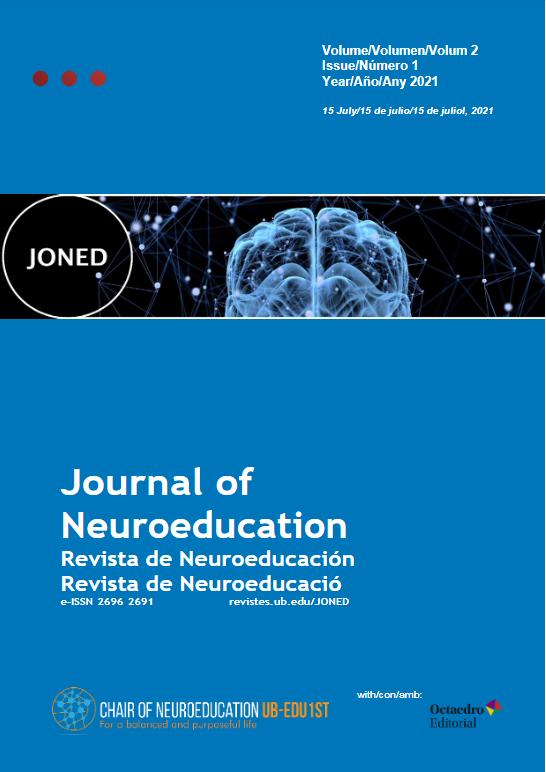Assessment process in the technical education: how teenager’s students show their emotions in challenging situations
DOI:
https://doi.org/10.1344/joned.v2i1.32744Palabras clave:
Emotions, Assessment, Learning, Teaching, Neuroeducation.Resumen
This article aims to analyze how students' emotions appear in challenging pedagogical situations, more specific periods of evaluations in regular face-to-face classes. The research is characterized as qualitative phenomenological. The data were collected through a semi-structured questionnaire, analyzed according to the Discursive Textual Analysis methodology. The context in which the investigation was carried out is the integrated technical education of a campus of the Federal Farroupilha Institute, a technical education institution in the south of Brazil. The analysis of the data collected showed that in assessment situations, negative emotions such as anxiety, fear, and insecurity predominate. On the other hand, negative emotions may vary, depending on the assessment instrument used, but they are predominantly associated with the evidence. The analysis showed that it is necessary to look for alternatives to minimize the effects of negative emotions on the teaching-learning process, especially about the evaluation process, and to find ways to improve these practices so that they contribute to learning with more quality.
Citas
1. Lent R. Cem bilhões de neurônios? Conceitos fundamentais de Neurociência. São Paulo: Editora Atheneu; 2010(2).
2. Ledoux J, Damásio A. Emotions and feelings. In.: Kandel ER, Schwartz JH, Jessell TM, Siegelbaum SA, Hudspeth AJ. Principles of neural science. McGraw-Hill Global Education Holdings; 2014(5).
3. Maturana H. Emociones y lenguaje en educación y política. Madrid: Ediciones Dolmen Ensayo; 2002.
4. Cosenza RM, Guerra LB. Neurociência e educação: como o cérebro aprende. Porto Alegre: Artmed; 2011.
5. Cosenza RM, Guerra LB. Neurociência e educação: como o cérebro aprende. Porto Alegre: Artmed; 2011.
6. Cosenza RM, Guerra LB. Neurociência e educação: como o cérebro aprende. Porto Alegre: Artmed; 2011.
7. Bicudo MAV. Pesquisa qualitativa segundo a visão fenomenológica. São Paulo: Cortez; 2011.
8. Bicudo MAV. Pesquisa qualitativa segundo a visão fenomenológica. São Paulo: Cortez; 2011.
9. Bicudo MAV. Pesquisa qualitativa segundo a visão fenomenológica. São Paulo: Cortez; 2011.
10. Bicudo MAV. Pesquisa qualitativa segundo a visão fenomenológica. São Paulo: Cortez; 2011.
11. Moraes R, Galiazzi MC. Análise textual discursiva. Ijuí: Editora Unijuí; 2011.
12. Cosenza RM, Guerra LB. Neurociência e educação: como o cérebro aprende. Porto Alegre: Artmed; 2011.
13. Herculano-Houzel S. O cérebro em transformação. Rio de Janeiro: Objetiva; 2005.
14. Luckesi C. Avaliação da aprendizagem escolar. São Paulo: Cortez; 2005(17).
15. Luckesi C. Avaliação da aprendizagem componente do ato pedagógico. São Paulo: Cortez; 2011.
16. França EB, Diniz C. A influência do afeto no processo de aprendizagem. In.: Velasques B, Ribeiro P. Neurociências e aprendizagem: processos básicos e transtornos. Rio de Janeiro: Rubio; 2014.
17. Ledoux J, Damásio A. Emotions and feelings. In.: Kandel ER, Schwartz JH, Jessell TM, Siegelbaum SA, Hudspeth AJ. Principles of neural science. McGraw-Hill Global Education Holdings; 2014(5).
18. Cosenza RM., Guerra, L. B. Neurociência e educação: como o cérebro aprende. Porto Alegre: Artmed; 2011.
19. Santos BS. A cruel pedagogia do vírus. Coimbra: Almedina; 2020.
Descargas
Publicado
Número
Sección
Licencia
Derechos de autor 2021 Louise do Pinho, Elena Mello

Esta obra está bajo una licencia internacional Creative Commons Atribución-NoComercial 4.0.
Los autores que publican en esta revista aceptan los siguientes términos:
a. Los autores conservan los derechos de autor y otorgan a la revista el derecho de la primera publicación.
b. Los textos se publicarán bajo una Licencia de Atribución No Comercial Creative Commons que permite a otros compartir el trabajo, siempre que incluyan un reconocimiento de la autoría del trabajo, su publicación inicial en esta revista y los términos de la licencia, y no se haga un uso comercial.



